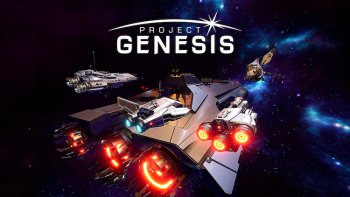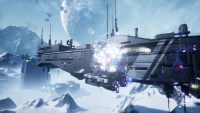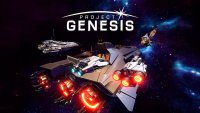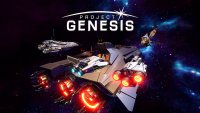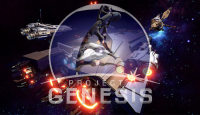
Show and Tell
Over the past two months Project Genesis has seen a lot of changes. If you’ve been following our social media channels, especially Twitter, you’ll have seen a regular stream of content from us highlighting some of the progress the Project Genesis team has been making. We thought we’d take a moment to showcase some of the updates into a handy article.

HUD Exploration
Balancing what information is placed on the screen and how it is presented is generally a highly iterative process. Design must contend with how to provide the maximum view of the environment while also providing information that is pivotal to the player.
In Project Genesis, we also have the added challenge of ensuring a seamless transition between the expansiveness of epic space combat to the claustrophobic close quarters combat while in FPS mode. We have begun exploring options. There is still a considerable amount of work to do in this area and we’d love to hear your opinions on what kinds of HUDs you think really hit the mark.
Network Code
In addition to employing a rapid development model, the team has a history of tackling the bigger challenges in game development first. In this case, after rapid prototyping out some initial-phase net-code prior to the holidays, it was time to refactor and build out multiplayer in a more robust fashion.

Four vs Four…and More!
The team’s objective for the January 2019 milestone was to achieve 4v4 matches. We knew that it was overly optimistic to expect more than that with this first iteration. After some extensive internal testing we felt the code was sufficient to offer a playtest to our trusted ambassadors in our Discord channel. We also extended an offer to participate to other folks in our community who’ve demonstrated a keen interest, or who have been very engaged in conversations.
While there is almost always a bit of stress when letting anyone external to the core team test your extremely early product, Christian’s net-code exceeded expectations. In fact, we were even able to push into 5v5 territory with no significant networking issues. By all accounts the testers actually had a fun time getting their hands on the updates provided — especially around controls.
We’ve provided a small sample of some of the footage we recorded to get a sense for how these playtests go so you can see how the netcode is working for yourself:
16 Players — 8v8
For our February private playtest, we were intending to expand our feature set to include our new “breach and board” mechanic but it just wasn’t stable enough to justify putting our candidate Test Pilots through that level pain. They are a tenacious bunch, and they would have soldiered on with janky functionality, but the core team has limits on how much punishment they are willing to inflict on candidate recruits. Instead we opted to include a small update adding some weapon upgrades and experiment with the new armament in-game.
While the netcode from the previous playtest session only had minimal tweaks we thought we might want to not push things and create two servers to host the next round of playtesters. Instead, we decided to roll the dice and put everyone in one server just to see what happens. It turns out … Christian’s netcode held up and we were able to achieve an 8v8 match.
Here is the 8v8 playtest session in action:
We’ll have a follow up article for release soon on our private playtest sessions that will outline details for what features we were testing, and the lessons we learned.
Assault Pods
In the playtest videos above, you’ll notice that the combat ships are nudging up against the capital ships to gain entry. This behavior is necessary to trigger the use button “E’ to perform a breach and board mechanic. However, in the currently planned design, players will instead launch an assault pod designed to pierce the un-shielded hulls of capital ships. These pods contain a lethal payload in the form of an infiltration avatar. These avatars are inhabitable by the AI mind (in other words you) aboard the combat ships.
Below we have an example of the model in 3D for you to rotate and view:
Expanded Interiors and Environments
One of the benefits of having a full spectrum artist like Mark Nicolino on the team is the depth of expertise he applies to building environments — both interiors and exteriors. Mark came very close to becoming a legitimate architect. Fortunately for us, this background allows him to blend the functional and fictional in a way that is novel yet familiar.
Our current FPS interior environment was a placeholder test map that you’ll no doubt have seen many times — it is the F4 deck with the blue power cores rotating in unison. It is an excellent example of the visual bar we are shooting for, but it is time for an upgrade. On the design front, Isaac Barry has outlined a layout schematic for capital ship interiors. Those schematics are then handed off to Mark for beautification and finally in-engine implementation. Mark builds these maps on a grid in Maya based on the UE4 grid system, and then imports the finished design into the Unreal Engine. This process is where Mark’s skill really pays off, because he creates the interior pieces like legos and then snaps them together. This allows for rapid iteration while maintaining fidelity and maximizing layout options.
Developing environments in space provides an incredibly varied and beautiful palette for the player to explore. Whether it is a binary star system, asteroid hell, nebulae, or the icy tundra of a distant solar system, all options are on the table. Mark has also been working to implement additional exterior environments so the other maps we have been developing might get a little screen time.

New Team Members
With all those features as environments getting added, we have also been expanding our team. We’re including engineering firepower to help us with our backend capabilities, animation thanks to Cole D., and additional modeling chops with Adrian M. These guys are already digging in and you should be seeing the fruits of their labor in the coming weeks.
We also intend to seeing if there are other experienced Unreal Engineers/Programmers interested in developing Project Genesis with us. This should lower our Producer Terry’s blood pressure and help increase the rate of production and feature implementation. A new team member has the added benefit in allowing us to show you cool stuff even more frequently. If you, or someone you know, loves getting under the hood in UE4 please let us know!
Join us in the Conversation
Project Genesis is a work in progress, so we’re always looking to hear from those of you who think there’s a place for a space combat FPS genre mash up in everyone’s game library. Please jump into our Discord today and give us your thoughts. There are a lot of other topics to provide feedback on — and you might even be enlisted as a Test Pilot if you are looking for a challenge and are obsessed with helping make the best possible hero-shooter-space-combat-FPS game out there!
About the Author: James Mayo is the Founder and Navigator at 8 Circuit Studios. He’s a grizzled veteran of the games industry — starting his career at Nintendo way back in 1990. You can find him occasionally blabbing about blockchain games on Twitter.
About 8 Circuit Studios: 8 Circuit Studios is a small independent game company made up of game developers and crypto-enthusiasts with big aspirations. They are working hard to develop rich gaming experiences on the Ethereum blockchain and whose vision is to contribute to the metaverse one game at a time. For more on 8 Circuit Studios, be sure to follow them on Twitter, YouTube, Facebook, or join the conversation in Discord.
